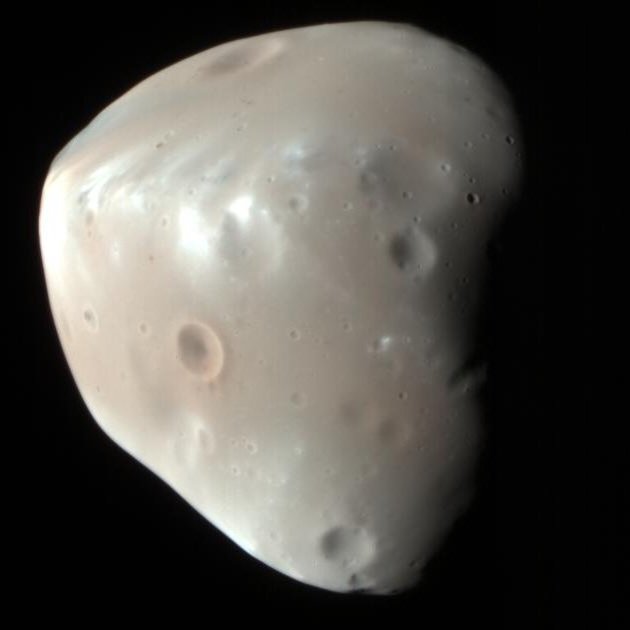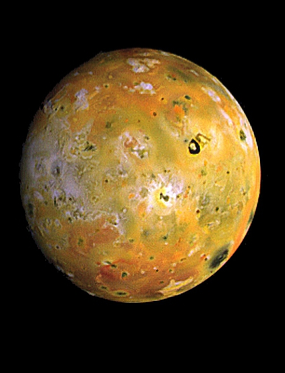*This post may contain affiliate links. This means we may make a commission if you purchase an item using one of our links*
The main differences between Deimos and Io are that Deimos is far smaller with a diameter of 12.4km compared to Io’s 3,643km, Io is the most volcanically active entity in our solar system while Deimos has no volcanic activity and Io orbits Jupiter while Deimos orbits Mars.
There are various other differences between the two so, continue reading to learn more about these natural satellites along with their similarities and differences below.
What Is The Moon Deimos?
Table of Contents

Deimos is the smaller and outermost of the two moons of Mars, named after the Greek God of dread and terror (the brother of Phobos). This satellite was also discovered by American astronomer Asaph Hall just five days before Phobos (12th August 1877).
Scientists like Johannes Kepler had put forward theories for the existence of these moons many years before they were discovered. Their calculations were based on the fact that the planets on either side (Earth and Jupiter) possessed one and four moons, respectively.
Still, none were discovered until the 19th century. One of the main reasons for this is that the tiny size of Phobos and Deimos, combined with an exceptionally close orbit to their planet, means that the glare of Mars often obscures our view of them.
Phobos measures just 15 x 12 x 11 km and completes an orbit of Mars once every 30 hours.
This tiny moon is also a heavily cratered landscape shaped by the impact of asteroid collisions over time. However, the material thrown up from these impacts doesn’t appear to have landed back on the moon’s surface as it usually would. This could be because the lack of gravity on Phobos allowed the ejected material into space.
The surface gravity on Deimos is just 0.003 m/s^2 (compared to 9.807 m/s^2 on Earth), which means the average gravitational pull of Deimos is only 0.003 m/s. With only 1/2500th of Earth’s gravity, you would need a tether to walk on this rocky moon, or every step would put you at risk of achieving escape velocity and launching yourself into space.
The composition of Deimos is similar to Phobos, suggesting that it might also be a captured asteroid. Its surface is very dark gray and has an albedo of around 0.07, meaning it reflects just 7% light (about half of the light Earth’s moon can reflect).
What Is The Moon Io?

The Moon Io – also known as Jupiter I – is the third largest of the Galilean moons, which has the closest orbit to Jupiter. It is the fourth-largest moon in our solar system by size – with a diameter of 3,643km – but has the highest density of all moons in the Milky Way.
In addition, Io has the strongest surface gravity of all moons and the least water by atomic ratio compared to any other astronomical object in our solar system.
Perhaps the most interesting feature of this lunar body is the 400 active volcanoes on its surface, which make it the most volcanically active object in the Milky Way; some of these volcanoes can exude plumes of sulfur to a height of several hundred miles.
The reason for this intense activity is the tidal heating caused by friction in the moon’s interior. Thanks to Io’s proximity to Jupiter, it finds itself caught between the gravity of its planet plus the two nearby moons – Ganymede and Europa. And this creates extreme tidal forces.
A side effect of these tidal forces is heat, which keeps most of Io’s crust in liquid form. Because of this, the surface of Io experiences a constant state of renewal; sites once home to large craters are slowly filled with molten lava and liquid rock.
While the complete makeup of Io’s surface is not yet defined, theories suggest that its main component could be sulfur and sulfur compounds because of the varied coloring. Silicate rock could also be a likely component as it would account for the high temperatures.
Io orbits Jupiter from a distance of around 422,000km, with an orbit that takes 42.5 hours to complete. Sitting 778,000,000km from the Sun, the surface temperature of this planet sits around -130 degrees Celsius. But due to the intense volcanic activity, the lava flows can reach temperatures of 1649 degrees Celsius, which is far hotter than anything on Earth.
Similarities Between Deimos And Io
As both are natural satellites, Deimos and Io do share a few similarities, which includes the following:
- Both have a rocky, terrestrial surface.
- Neither have rings surrounding them.
- Both are tidally locked to their planet.
- Both orbit their planet in an elliptical pattern.
- Neither have tectonic plates.
- Neither have a magnetic field.
- Europa and Phobos have a practically non-existent axial tilt.
Differences Between Deimos And Io
As for the differences between the two, they include the below.
- Deimos orbits Mars whilst Io orbits Jupiter.
- Io is a spherical shape while Deimos is not.
- Io has a diameter of 3,643km whilst Deimos has a diameter of 12.4km.
- Deimos has no atmosphere whilst Io has a very thin atmosphere composed of oxygen and hydrogen
- A day on Deimos takes 30 hours whilst an Io day is 42 hours.
- It takes Deimos 30 hours to orbit Mars and around the Sun in 687 days whilst Io orbits Jupiter in 42 hours and the Sun in 12 years.
- Deimos’ temperature ranged between -4 to -112 degrees Celsius whilst Io’s is around -130 degrees Celsius.
- Io’s density is 3.53 g/cm³ whilst Deimos density is 1.47 g/cm³.
- Io’s mass is 1.345×10^23 kg whilst Deimos’ mass is 1.4762 × 10^15 kg.
- Deimos’ gravitational strength is 0.003 m/s² whilst Io’s is 1.796 m/s².
- Io orbits Earth at an average distance of 422,000km whilst Deimos is 24,680km away from Mars
- Io has a central core while Deimos does not.
- Io is the most volcanically active entity in our solar system while Phobos is not volcanically active.
Summary
Io and Deimos may both be one of multiple moons orbiting their respective planets and are tidally locked to their planets but, in the grand scheme of things they are very different from one another.
Whether it be in regards to mass, size, their volcanic activity, gravitational strength, how dense each body is, their shape and more. Therefore, despite the fact both are rock based celestial bodies, they have many distinct features that easily distinguish the two from one another.
